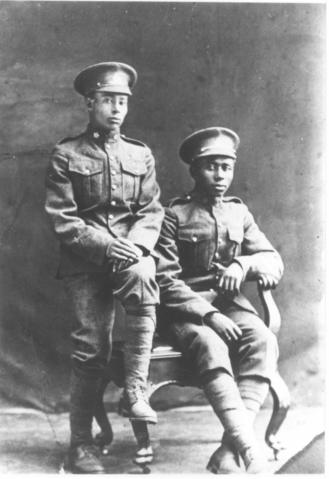Lulu Jane Anderson, civil rights activist (born around 1885–86 in Atlantic City, New Jersey; date of death unknown). Lulu Anderson was a Black woman who sued the Metropolitan Theatre in Edmonton for refusing her entry to the theatre. Her court case gained widespread interest at the time with her trial covered by many newspapers. Lulu’s case is notable in that it was an early example of Black civil rights activism in Alberta. Her actions alongside those of other Black activists show that resistance to segregation was common across Canada throughout the 1900s.
Historical Context
Lulu Anderson lived in a context of strong anti-Black racism in Alberta.
Black history in Alberta goes back 200 years. (See Black History in Canada until 1900.) The earliest recorded Black Albertans were fur traders who came to Alberta for work. (See Black Fur Traders in Canada.) The largest cohort of Black immigrants to Alberta arrived in the early 1900s from the United States. The resistance they faced was immediate. In 1911, the Edmonton City Council passed a motion calling for the end of Black immigration. The motion made reference to Black Albertans causing damage to the “fair” province, stating they were incapable of properly coexisting with white Albertans.
In 1911, Lethbridge Conservative activist C.E. Simmonds gave a speech that was printed in the Edmonton Evening Journal called “We Want No Dark Spots in Alberta.” He was worried that the large cohort of Black immigrants would lead to “Alberta being called ‘Black Alberta.’” Simmonds also stated that “we do not want to have this name attached to us, nor do we want the province black in spots.” (See also Order-in-Council P.C. 1911-1324 – the Proposed Ban on Black Immigration to Canada.)
This resistance caused Black immigration to decline. Black communities persisted nonetheless but so did discrimination.
In 1924, Black patrons were banned by the City of Edmonton from using the Borden Park swimming pool. In the 1920s and 1930s, Edmonton hospitals refused to treat Black patients. In 1938, Rhumah Utendale tried to become the first Black nurse in Edmonton but was refused entry because she was Black. (See Racial Segregation of Black People in Canada.) It is also important to note that the rise of the Ku Klux Klan in Alberta occurred in the 1920s and 1930s.
Life in Canada
Very little is known about Lulu Anderson’s life due to limited archival records and the destruction of the legal records related to her case. What we do know is that Anderson was born in Atlantic City, in the United States, around 1885 or 1886.
Anderson eventually moved to Edmonton, Alberta, and lived at 9609 105th Avenue. She was active in her local church and was involved in its choir. Edmonton Bulletin articles made frequent mentions of her, noting that she once sold 100 tickets for a church choir performance. Anderson performed for MLA Nellie McClung ― one of the “Famous Five.”
Lulu Anderson v. The Brown Investment Company
On 12 May 1922, Lulu Anderson went to the Metropolitan Theatre to watch a performance of The Lion and The Mouse. The theatre staff denied her entry. According to an article in the Edmonton Journal, the staff also assaulted her.
The Edmonton Journal reported that she proceeded to hire lawyer Samuel Wallace of the law firm Joseph A. Clarke and Company.
A column titled “Our Negro Citizens” in the Edmonton Journal reported on Anderson’s legal action. The piece mentioned that “a court action of considerable importance to the colored residents of the city has been commenced” by Anderson on “account of her color.” The column goes on to mention that Anderson and a friend purchased tickets in the orchestra seats but were “roughly pushed back and assaulted.” It described how racialized residents would follow these events with interest “as their rights under the British flag are being tested.” (See also Imperialism.)
Anderson’s case lasted from 26 May 1922 to 3 November 1922. Judge Lucien Dubuc ruled against Lulu Anderson. The Winnipeg Evening Tribune reported on his ruling, stating that “management... could refuse admission to anyone upon tendering (refunding) the price of the ticket.” The decision cemented the practice of racial segregation in Alberta. The Winnipeg Evening Tribune reported on the decision with a headline that declared “Color Line Confirmed.”
Destroyed Records
Court records related to Lulu Anderson’s case are difficult to find because all case files for the period of 1921 to 1949 were destroyed in 1971.
Marlena Wyman ― a former historian laureate of Edmonton ― mentioned that the records’ destruction was decided upon by the government and not the archives.
Having a full record of her case would allow researchers to better understand Lulu’s legal odyssey. For example, the court records of Charles Daniels ― a Black Calgarian who launched a similar court case in 1914 ― are available. Thanks to those records, we are able to determine his rationale for seeking legal action in his own words. In Lulu Anderson’s case, most if not all news stories did not quote her or share her words.
As a result, we are only able to infer and imagine the impact such a case had on Anderson ― a Black woman who lived in a city with racial segregation and where the Ku Klux Klan was on the rise.
Legacy
Lulu Anderson lost her case but her legal fight was significant. She resisted racial segregation 20 years before Viola Desmond and 30 years before Rosa Parks. However, while Rosa Parks and Viola Desmond are well-known and remembered, very little is known about Lulu Anderson.

 Share on Facebook
Share on Facebook Share on X
Share on X Share by Email
Share by Email Share on Google Classroom
Share on Google Classroom



